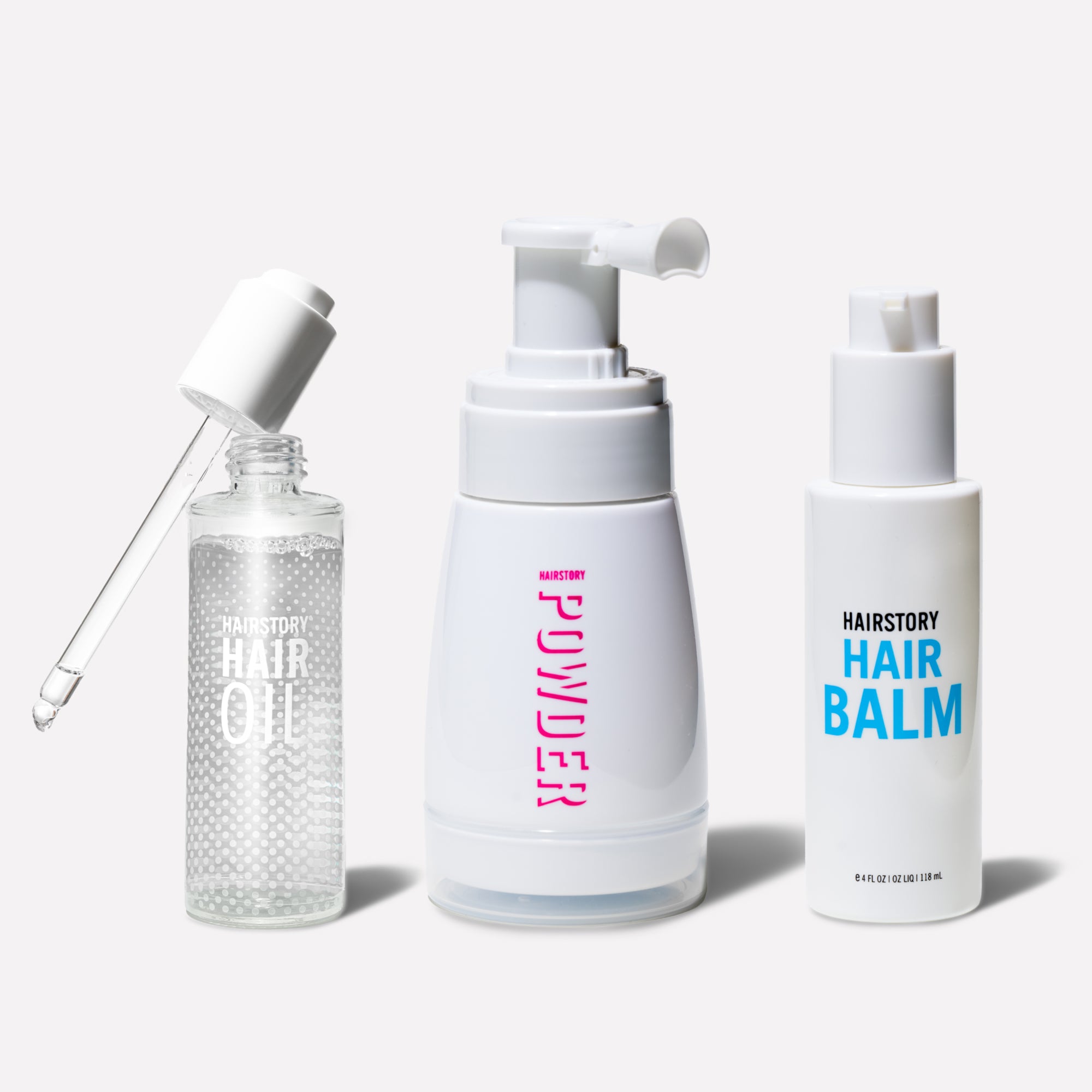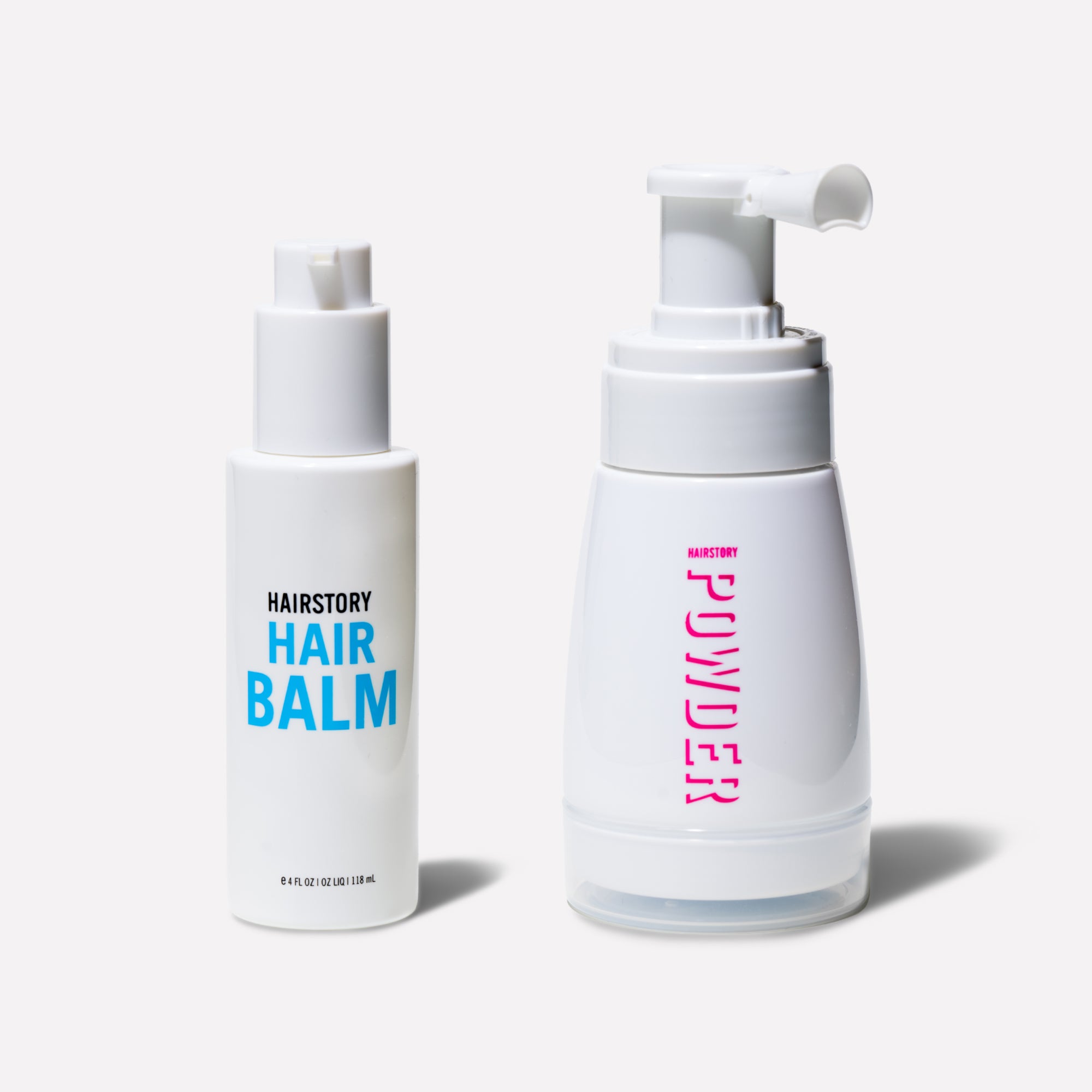For most of us, gray hair is inevitable—up to 23% of people will have half of their hair turn gray by the time they turn 50.
Of course, many aren’t bothered by a few gray strands. Over the past several years, there’s been a noticeable uptick in celebs and influencers embracing their natural gray hair—or even intentionally dyeing it to achieve a fashionably silver style (see: Kim Kardashian). But it’s far more common to want to prevent or cover gray hair.
Whether you decide to embrace the look or cover it up, getting your first few grays can be a bit unsettling. What’s happening to your hair? And if you’re not up for wearing silver strands, can you reverse the trend and prevent gray hair altogether? Read on for everything you need to know.

WHY DOES HAIR TURN GRAY?
If you’re worried that an extra-stressful event could make you go completely white overnight, take a deep breath—that’s not exactly how it works. In reality, going gray is generally a gradual process.
Every strand of hair on your head grows from a follicle—a tube- or tunnel-shaped structure in your scalp. Each follicle contains pigment cells (melanocytes), which generate melanin, the pigment that determines the color of your hair. As you age, your pigment cells gradually die, which causes each strand of your hair to contain less melanin, making it more transparent.
Gray hairs are actually clear, but they can look white, gray or silver depending on how they appear against your natural hair and how light hits them. The natural color of your hair makes no difference in your likelihood of going gray.
You may first notice gray hairs at your temples, and then progressively toward the top of your scalp. Eventually, it will affect your entire head of hair. However, it’s a gradual process, and it can take years—in some cases, more than a decade—to go completely gray.
WHAT CAUSES GRAY HAIR?
So, what causes gray hair? Gray hair is most often caused by the natural aging process. However, premature graying—when hair whitens earlier than expected—can be a result of several different factors. To learn how to prevent hair from turning gray, it’s a good idea to understand why it happens in the first place.
Aging and Genetics
Aging is the most common cause of graying hair; as your hair follicles produce less melanin, your hair will grow in gray. This commonly begins at around age 35 but can vary based on your specific genetics. Some people will notice gray hairs (or even go completely gray) as early as high school, while others will be well into their 40s before they notice a silver strand or two.
If you want a clue as to when you’ll go gray, look at both sides of your family tree—graying isn’t exclusive to just one side of your lineage. Consider if and when either of your parents went gray, and you’ll have a reasonable idea of when you might start to see some silver.
Stress
Can stress cause gray hair? While one stressful event won’t immediately shock your hair completely white, research shows that stress can lead to more grays.
Stress can trigger a condition called telogen effluvium, which causes your hair to shed about three times faster than it normally would. If your hair follicles are already generating silver or gray strands, this expedited hair loss/growth cycle can lead to the production of more gray hairs.
Vitamin and mineral deficiencies
Certain vitamin and mineral deficiencies can cause your hair to whiten. A lack of vitamin B12, for example, is one of the most common deficiencies linked with premature graying. Low levels of B12 are often seen alongside deficiencies in folic acid and biotin.
Premature graying has also been linked to deficiencies in:
- Vitamin D
- Iron
- Zinc
- Vitamin B5
Illness
It’s also possible for your hair to lose its pigment due to certain medical conditions and illnesses. For example, research from the Journal of Clinical Endocrinology and Metabolism (JCEM) shows that thyroid-related disorders, including thyroid disease, hyperthyroidism and hypothyroidism, can cause early graying.
Autoimmune conditions, in particular, have been linked to the development of white hair. In these conditions, the body’s immune system attacks its own cells—including hair cells. This can cause a loss of pigment and, as a result, gray hairs.
Medical conditions and autoimmune diseases that can trigger gray hair growth include:
- Neurofibromatosis (Von Recklinghausen’s disease)
- Tuberous sclerosis
- Vitiligo
- Alopecia areata
Smoking
Researchers at the Indian Dermatology Online Journal have found a link between smoking and the onset of gray hair growth before age 30. Because smoking restricts blood vessels, it can reduce blood flow to the hair follicles and lead to hair loss. In addition, the toxins in cigarettes can damage the hair follicles, leading to premature gray hair growth. Ultimately, that means smoking can lead to thinning and graying hair.
HOW TO PREVENT GRAY HAIR NATURALLY
While in some cases you can reverse gray hair, it’s not a guarantee—so you may be better off learning how to prevent gray hair naturally. Here are a few tips:
Address Potential Vitamin Deficiencies
Because your hair can turn gray as a result of certain deficiencies, such as a lack of iron, B12 or vitamin D, start by having a conversation with your doctor. Proactively pinpointing and addressing any deficiencies now can help make sure your hair doesn’t change color prematurely. This may involve taking supplements or changing your diet.
Learn to Better Manage Stress
It’s a cliché for a reason: Research shows that stress can trigger premature graying. Aim to reduce unnecessary stressors in your life, or learn to deal with stress in productive, positive ways through, for example, exercise, deep breathing or meditation.
Quit Smoking
A study from the International Journal of Trichology found that smoking can cause premature graying. For this reason—and arguably many more—ditching the cigarettes can boost your chances of maintaining your natural hair color for longer.
Eat a Nutrient-Rich Diet
You can’t exactly trigger or stop gray hair growth based on your diet, but eating certain foods can help mitigate the vitamin and mineral deficiencies that can lead to white hairs. Lentils and chickpeas, for example, are good sources of vitamin B9, or folate. Salmon can provide vitamin D, and tuna, trout and sardines all offer a healthy dose of vitamin B12. In addition, walnuts are an excellent source of copper, which can aid melanin production in your hair.
Avoid Hair Products with Harsh Chemicals
Harsh hair products, from hair dyes to shampoos, can contain ingredients that decrease the hair’s natural melanin, such as hydrogen peroxide, which can lead to early graying. Take inventory of your hair care routine and opt for natural, non-damaging products. Plus, by choosing a hair cleanser that protects your hair and keeps it moisturized, you can ensure it looks healthy even when it begins to gray.
Hair Cleansers
shop the collection
View More Information



New Wash Original
View More Information


Healthiest Hair Method
View More Information


Richest Hair Method
View More Information


Clarifying Hair Method
View More Information


Pre-Wash
View More Information


New Wash Original Starter Set
View More Information


New Wash Rich Starter Set
View More Information


New Wash Deep Starter Set
View More Information


New Wash Original Trial Kit
View More Information


New Wash Rich
View More Information


New Wash Deep
View More Information


Massaging Scalp Brush
View More Information


The New Wash Method for All Hair Types
View More Information


The New Wash Method for Dry Hair
View More Information


The New Wash Method for Oily Hair
View More Information


New Wash Original and Purple Boost Duo
View More Information


New Wash Rich and Purple Boost Duo
View More Information


New Wash Original and Blue Boost Duo
View More Information


New Wash Original and Red Boost Duo
View More Information


New Wash Rich and Red Boost Duo
View More Information


New Wash Rich and Blue Boost Duo
View More Information


Anti-Brass Moisture Color Boost Set
View More Information


Anti-Brass Color Boost Set
View More Information


Beach Waves Set
View More Information


Care and Texture Set
View More Information


Beach Waves Moisture Set
View More Information


Moisture Ultra Boost Set
View More Information


Moisture and Shine Restoration Set
View More Information


Frizz Control Set
View More Information


Moisture and Volume Set
View More Information


Moisture Boost Set
View More Information


Frizz Control Moisture Set
View More Information


Vibrant Red Color Boost Set
View More Information


Shine, Gloss and Moisture Color Boost Set
View More Information


Vibrant Red Moisture Color Boost Set
View More Information


Volumizing Set
View More Information


Shine Restoration Set
View More Information



New Wash Mini
View More Information


Bond Boost and New Wash Deep Duo
Keep in mind that when and how quickly your hair turns gray is determined largely by something you can’t change: genetics. However, by learning how to prevent gray hair naturally, you can keep hair looking younger longer. Plus, following these tips will protect your hair even as it begins to whiten—whether you choose to cover it up or embrace it, your hair will stay healthy, supple and strong.
EFFECTIVE HOME REMEDIES FOR REVERSING GRAY HAIR
Wondering how to get rid of gray hair? You’ve probably found a range of home remedies on the internet that promise to help darken hair that has turned gray. Most include ingredients that are designed to act as a natural dye, like black tea, henna, coffee and potato peels. However, DIY remedies can produce mixed or unexpected results, especially if you already have color in your hair. Often, they will result in a warm red or orange hue, rather than the natural tone you were hoping for.
Plus, gray hair coverage can vary based on your original hair color and the percentage of your hair that’s already turned silver. For example, gray hair isn’t as visible in blonde hair, so highlights can be sufficient to target and camouflage gray patches. Gray hair stands out more prominently against dark hair, however, so brunettes typically require more full coverage. Ultimately, for the best results, consult with your stylist about the most effective color and care as you begin to see grays.
Techniques to Avoid
Plucking Gray Hairs
You may be tempted to simply pluck new grays you see. However, repeated plucking can actually damage the hair follicle and lead to permanent hair loss. If you want to get rid of grays, coloring your hair is a better option.
Using Box Hair Dye
You may choose to grab a box of hair dye to cover up those grays, but that’s not the best approach for a couple of reasons. One, just as over-processing or over-coloring can damage normal, healthy hair, it can even more harshly affect gray hair. Some people find that their silver strands become dry and coarse—and that coarseness can make it harder for color to penetrate. You may have to allow the color to sit on your hair for longer, causing damage. If you’re wondering how to care for coarse hair, your best option is to talk to a professional stylist about how to properly color and keep it healthy.
The Benefits of Professional coloring
Speaking of professionals: The look you’ll get by working with a colorist will beat a store-bought style every time. Dye works differently on different hair shades—including gray—so that lovely shade of summery blonde or chestnut brown you see on the box might not be exactly what winds up on your head. Whether it’s choosing the right all-over color for your hair and skin tone, incorporating highlights, or creating a funky fire-and-ice look, a stylist can create a custom color plan that’s tailored to you. No box can beat that!
CAN GRAY HAIR BE REVERSED?
If you want to learn how to stop gray hair naturally, your best bet may be to focus on leading a less stressful life. A study by researchers at Columbia University Vagelos College of Physicians and Surgeons found evidence that gray hair caused by stress can turn back to its original color if the stressor is removed.
The researchers believe that hair must reach a threshold before it turns gray. If you are in your 30s or 40s—when hair is near that threshold based on your age and genetics—stress can push your hair over that threshold and cause it to turn gray. If you remove the stressor, you may see your hair transition back to its natural color. However, you likely need to be biologically near that threshold for the science to hold up. If you’ve been gray for many years, reducing stress probably won’t have an impact on your hair color.





